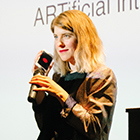 In association with the Lumen Awards, the BCS Artificial Intelligence Award for Digital Art has been designed to give recognition to artists and their work who have used some form of artificial intelligence in the production of a piece of art. Technology has always been involved in the extraordinary creativity of artists - and computer technology has unleashed yet more opportunities to express feeling and reflect the human condition. BCS wants to celebrate the coming together of algorithmic processes and the artist’s creative aesthetic.
In association with the Lumen Awards, the BCS Artificial Intelligence Award for Digital Art has been designed to give recognition to artists and their work who have used some form of artificial intelligence in the production of a piece of art. Technology has always been involved in the extraordinary creativity of artists - and computer technology has unleashed yet more opportunities to express feeling and reflect the human condition. BCS wants to celebrate the coming together of algorithmic processes and the artist’s creative aesthetic.
The BCS Artificial Intelligence Award for Digital Art is the first art award that the Institute has sponsored - but it is nevertheless part of a 60-year legacy. BCS is celebrating its 60 years during 2017 and 2018 - enjoying the past, drawing attention to the issues of now, but also looking forward so all of us can make IT good for society. Art plays a pivotal role in what it means to be human - and our member magazine has covered the confluence of technology and art from 1968, with the set up of the BCS Computer Arts Society, to the present day. To paraphrase Brian Eno, all the things we don’t have to do can be considered art - and we want to showcase how this most human activity has been furthered by modern technology.
The initial shortlisting was done by a panel of BCS judges: Catherine Mason, author of ‘A Computer in the Art Room’; Nick Lambert, Chair of the BCS Computer Arts Society and Brian Runciman, Editor of ITNOW and BCS Dilettante in Residence. The subsequent final choice was made by the Lumen panel of distinguished judges.
Let’s be frank
The winner of the 2017 BCS Artificial Intelligence Award was ‘FRANK - ARTificial intelligence’ by Cecilie Waagner Falkenstrøm, of Denmark. FRANK is a super intelligent post-human being - a contemporary oracle that gives personal guidance regarding existential dilemmas. Using artificial intelligence the audience can have a direct dialogue with FRANK who answers with a humanised voice. Cecilie received a $1,000 prize and will also appear in the BCS’s 60th anniversary celebration book, to be published in 2018.
Amongst the judges’ comments on the winner were the following: ‘The artist is asking very relevant questions in her statement and obviously understands the issues behind AI. There are historic precedents for artists asking viewers to question the maker, for example A M Noll’s Mondrian Experiment.’
‘This piece has a proper algorithmic underpinning.’
‘As an audio piece, this is quite a departure from the other entrants, and points to a much deeper understanding of AI. Paradoxically it is quite dependent on where it is sited, even though it lacks any visual element, because the surroundings will impact on the conversation in various ways. I think has a lot of potential and invokes the Turing Test as well, asking questions about one’s relationship to a disembodied artificial being.’
BCS’s arts legacy
BCS has been involved in covering computer use in the arts for nearly 50 years. It was in 1968 that the Computer Arts Society Specialist Group was founded, under the aegis of BCS, by Alan Sutcliffe, George Mallen, and John Lansdown. All now well-known names in the history of computer art.
Through the years the Computer Bulletin and ITNOW have covered art with a long series of articles from John Lansdown - including depicting animation stills, reproducing dance scripts, and even featuring electronic musical instruments, such as the now renowned Synthi 100.
More latterly, Catherine Mason ran a blog for BCS, also covered in ITNOW, that included contributions from David Hockney (an iPad picture), a Grayson Perry computer generated embroidery and much more.

















